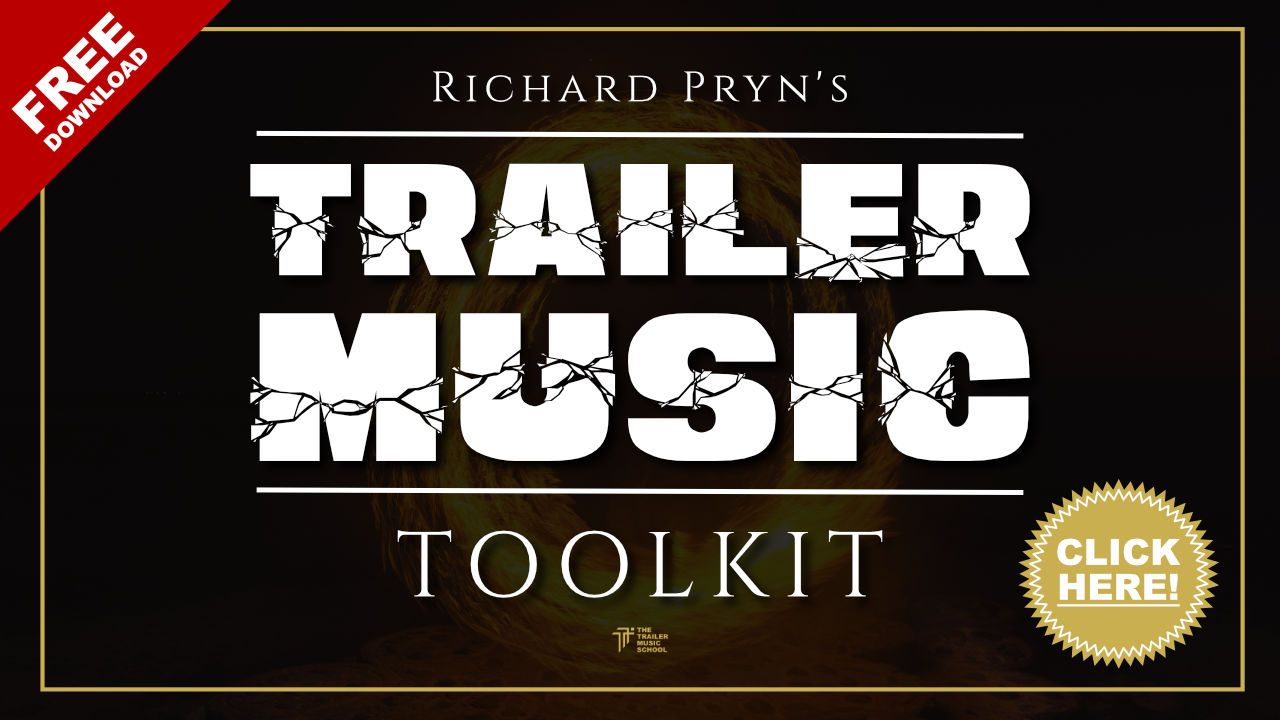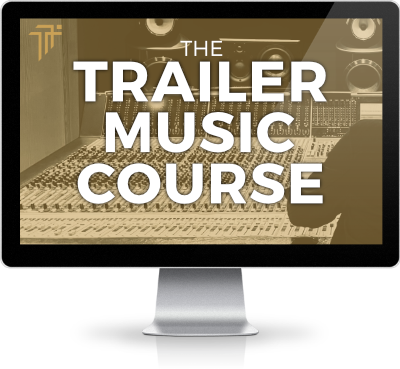I wrote a piece of music for a trailerized string quartet last year. It recently got placed and became The Lost King trailer music.
As you know I am a huge fan of sharing, especially sharing my knowledge, experience, and process.
I want to share with you exactly how I created the music; what I was thinking at the start and how I developed it into an entire piece of trailer (production) music.
It all starts with a single idea
I wrote 4 albums of trailerized string music last year and the premise was the same for each and every track; how can I come up with a single musical idea and make it into an entire piece of music?
This track started with just that, a very simple rhythmic idea.
And for those of you who aren’t familiar with music notation:
It’s essentially a rhythm playing with an octave. I chose an octave because an important part of all trailer music is to not give everything away too soon.
This meant that rather than playing an interval that gave away the tonality (major or minor) of the track, I chose an interval that could be either way. To be honest there are only really a couple of intervals that are fairly neutral; the perfect fifth and the octave.
Even the major second leans too much to the positive when played on its own.
You will see this rhythmic idea all throughout the piece. I simply started to pass the idea around to the other instruments.
The trick here is to maximize the amount of time that your idea takes up in the track. Not to be lazy but as listeners, we will hear each new thing as a development, even if it is not an actual development but actually just another sound doing the same thing.
This means that if you hear a simple pattern played by the cello for a few bars, when the viola comes in to play the same thing you will think, “oh hey, this track is growing and developing nicely”
This is what I often do and to great effect.
Small changes are your secret weapon
The next trick I employed was to take that idea and change something small about it. I decided to keep the rhythm the same but to change the notes of if. Instead of the same notes, I used a descending pattern.
But I saved this little trick for when the second violin came in. Again stretching my idea out.
By the time the first violin came in all, it was doing was playing a pulse to drive the track forward.
Use octaves to give extra progression
Once you have repeated your idea enough times you then need to make a change to feel like the track is moving forward and not just looping. But how do you do that?
By taking one of your musical lines and moving it up an octave. In this instance, it was the second violin line I moved up an octave.

Get my FREE Trailer Music Toolkit
It contains all the One-shots you need to sketch a complete track, and the hugely popular Perfect Trailer Music Cue Blueprint PDF.
Build and drop
When you have reached the end of your act, make sure you build your music in some way to let the listener know it is coming, the stop-down that is.
This could involve fills, risers, rolls, increased speed of patterns, moving up in pitch, etc.
You also need to make sure you give the editors something to work within the breaks between your acts.
This way you build into something interesting and your track doesn’t lose pace or interest.
In this instance, I used a change in patterns to give the editor something to work with…which they did (see bar 21)
Make sure each musical line is doing its job
When it comes to writing a piece of music for a small ensemble (group of musicians) it is a really good idea to work on your ability to roll with one small idea.
The reason for this is that there will only be a small number of things that you can get those players to do so you have to be efficient with them.
Much like the composers who wrote the music for early video games. They would only have 4-8 channels to create their music on so they would have to make sure that each channel did enough to express their ideas.
The same is true when writing for a string quartet. You have to make sure that each player’s part is doing the job it is supposed to do.
This is how I approached act 2 and act 3 (see above). I wanted each line to add pace, and movement and also make it sound interesting.
The danger with writing very rhythmic stuff is that it can start to feel looped very quickly. This isn’t necessarily a bad thing but in trailer music, you do not want that.
How to take a single idea and turn it into a piece of music
This entire piece of music was an exercise in taking one musical idea and turning it into a piece of music with very few parts playing at the same time.
It is surprisingly hard to do but with a little practice, you will be able to take a simple rhythm and grow it into a beautiful piece of music.
The trick is to think of your idea as a piece of Lego; a small brick that you can use to build something new and different.
By adding more bricks to that single brick you change it and it gradually becomes something new.
This is what you do with your ideas; introduce and develop them slowly.
What I like to do is to take a rhythm and pass it around to the other instruments but instead of them playing it at the same time they start at different points. Just like a musical round or canon.
This is all from one of my musical heroes, Steve Reich.
He used this idea to create his amazing ‘Clapping Music’ which has been burnt into my musical vocabulary from the very first moment I heard it over 15 years ago.
How I “trailerize” my neoclassical music
Up until this point, I have been discussing how I write for a string quartet (essentially).
As trailer music composers, we need to take our ideas into the world of motion picture advertising.
What this means is that we need to make it feel like it fits on a trailer. We need to “trailerize” it.
The quickest and easiest way to do this is to use cinematic hits and transitions at every key moment of the track.
Here I used some Taiko rolls from 8dio Hybrid Tools 2.
Top Tip: Make sure you save your biggest sounding hits for Act 3 and start with distant more sub heavy hits in act 1.
I make my hits and transitions sound further away by rolling off the top end using a high-cut EQ.
In Act 2 I bring in some bigger-sounding hits at around 4 or 8-bar intervals. You can spatter smaller-sounding hits in between as a nice way to keep the track feeling huge.
When it comes to Act 3 I try to make sure that I use many biggest sounding hits and use them more frequently.
They would tend to emphasize every important chord change. This way it makes your third act feel like it has really ramped up in scale and pace.
I hope you enjoyed my breakdown of The Lost King trailer music.
I show you all this and everything in between in my flagship course, The Trailer Music Course. I show you the functions of all the acts and how to write licensable trailer music.

The Trailer Music Course
This is my flagship Trailer Music course. It was designed to teach you every single aspect involved in writing trailer music; from understanding structure, and creating your own sounds, all the way to a mixing and mastering masterclass with Toby Mason.






